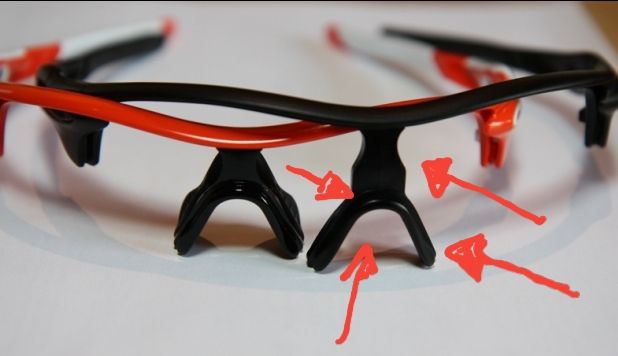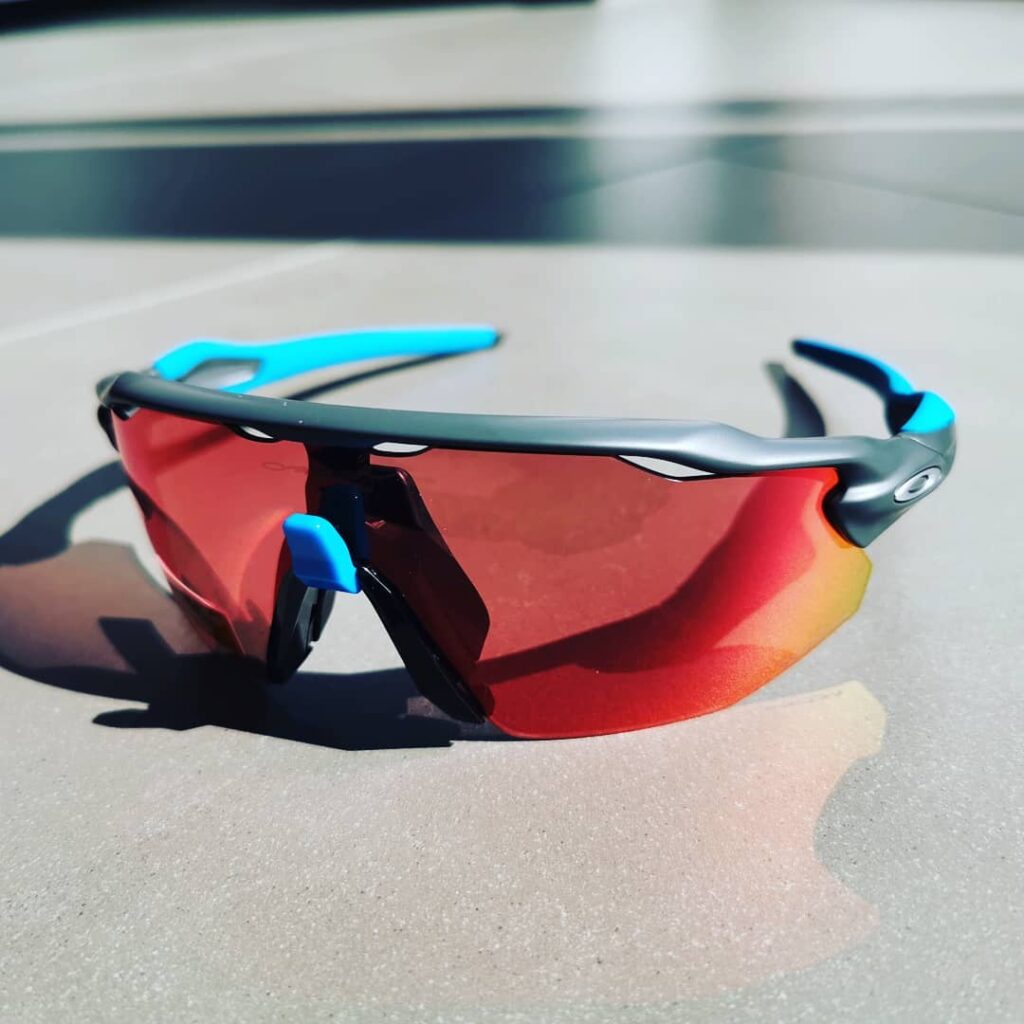We’ll break down the Oakley Radar, Radarlock, and Radar EV and explain the frame and lens differences so you can buy with confidence!
Table of Contents
Background
The Radar line has become one of Oakley’s most popular sports frames on the market. But as new Radar models have been released, like the Radarlock and now Radar EV, it’s become hard to know the differences.
In this guide, we’ll compare all three Radar models along with the Edge, Path, Pitch, and Range lens options available.
Oakley Radar Sunglasses
Frame Overview and Size
Oakley Radar sunglasses were originally released in 2006, these sunglasses were designed as a modern variation of the classic M Frame, with its wrap-around visor lens and clean lines. Featuring an O Matter and Unobtainium nose piece, the Radar is built to grip your face during sports such as cycling and shooting!
Radar Dimensions
Oakley Radar sunglasses are built for medium-to-large faces. We’ve included the dimensions below:
- Width: 133mm
- Length: 130mm
- Height: 44mm

Radar XL vs. Radar Sunglasses
Oakley also introduced the Radar XL, which features an additional ~7mm of vertical height from the nose bridge to the top of the frame compared to the standard Radar model.
Aside from the additional height, the Radar XL and Radar are the same sunglasses. For people with bigger heads, you’ll find the Radar XL model to be more comfortable and provide superior coverage.
Unfortunately, the XL only offers one lens size – “Blade”, which is often just referred to as “XL”. And because of the additional vertical height, Radar and XL lenses can’t be swapped across models.

How to Swap Radar Lenses?
Oakley Radar and XL lenses can be changed by applying pressure to the nose and edges of the lens, and pulling the lens out.
While it certainly takes getting used to, once you do it the first time, you’ll feel confident in changing the lenses. For more instructions, check out our step-by-step guide to changing Oakley lenses.
Oakley Radarlock Sunglasses
Frame Overview and Size
After the Radar, Oakley Radarlock sunglasses were released in 2012. The Radarlocks have now been replaced by the Oakley Radar EV, but they are still a popular frame today.
The frame features a shield lens and O Matter frame similar to the Radar. With mildly updated styling cues, the major improvement was the “lock”(ing) in the frame (more on that in a minute).
Radarlock Dimensions
Oakley Radarlock sunglasses are slightly larger than the original Radar frame as you can see from the dimensions below:
- Width: 138mm
- Length: 131mm
- Height: 44mm
Switchlock Technology
Deemed as “Switchlock” technology, the enhancement was hailed by Oakley as the future of the Radar line (more to come on that).
It allows for fast and secure swapping of lenses by simply flipping the “Switch” on the inside of the earstem. Once switched, the lenses will easily slide out and can be swapped before locking in again.
Overall it was designed to make replacing lenses in the Radar line even easier. And it was widely used in marketing the Radarlock.

Oakley Radar EV Sunglasses
Frame Overview and Size
Following the success of the Radarlock, Oakley launched the Radar EV in 2015. While we already covered a comprehensive review of the Oakley Radar EV, we’ll still cover the basics here.
With a similar design to the previous models, the Radar EV is once again a modern take on the Radar base. The biggest difference is the Extended Version or “EV” lenses which provided a larger viewing range.
In a complete reversal, Oakley went away from Switchlock technology, instead reverting to the pressure snap-in system they once called “outdated”. In the end, both systems work well, so there’s no real loss here.
Radar EV Dimensions
As you can see from the dimensions below the Radar EV expanded vertically in size:
- Width: 140mm
- Length: 130mm
- Height: 50mm

Radar EV vs. EV Advancer vs. EV XS
In 2019 Oakley updated the Radar family, releasing the Radar EV Advancer sunglasses.
Featuring a hinged nose-piece designed to move the entire frame 5mm further away from your face, preventing fogging during sports like cycling.
This nosepiece was first released on the Oakley Flight Jacket before being released on the EV Advancer.
These sunglasses also include a slightly larger lens with a flattened curve at the bottom compared to the Radar EV. Lenses can also be swapped between the Radar EV and Advancer as well.
For smaller heads, Oakley also released the Radar EV XS (or “Extra small”) version of the frame.
The Radar EV XS includes a 115mm frame width and a shorter lens height of only 45mm. Because of the frame width difference, lenses cannot be shared across the other Radar EV models in the line.
Path vs. Pitch vs. Range Lenses
Before we talk about the differences in the Radar line, it’s important to also discuss lenses.
Oakley offers 4 variants of the Radar lens, the Edge, Path, Pitch, and Range – all increasing in size by about 2-3mm between cuts.
The table below will cover the size differences in precise measurements. You can also find dedicated discussions on this topic on the forum.

Oakley Radar vs. Radarlock vs. Radar EV
Now that we’ve covered each of these frames – we’ll talk about the similarities and differences.
Overall the biggest differences are the lens size, shapes, and overall design. The table in the section below provides a quick and easy reference point to compare each of these models across the same or similar lens shapes.
In a poll conducted in 2018, the community responded that 47% preferred the Radar, 35% the Radarlock, and 9% the Radar EV. Though since the release of the Advancer, you may find an increase in EV popularity since any fogging issues have been solved.
| Radar | Radar XL | Radarlock | Radar EV | Radar EV XS | ||
|---|---|---|---|---|---|---|
| Temple / Earstem Length | 130mm | 130mm | 131mm | 130mm | 130mm | |
| Frame height | 44mm | 50mm | 44mm | 50mm | 45mm | |
| Frame Width | 133mm | 133mm | 138mm | 140mm | 115mm | |
| Available Lens Sizes | Edge (42mm) Path (44mm) Pitch (46mm) Range (49mm) | XL (50mm) | Edge (42mm) Path (44mm) Pitch (46mm) Range (49mm) | Path (50mm) Pitch (50mm) Advancer (52mm) | XS (45mm) | |
| Lens Swap | Pressure / Snap-in | Pressure / Snap-in | Switchlock Technology | Pressure / Snap-in | Pressure / Snap-in |

Where can I buy Oakley Radar Sunglasses?
You can find the Oakley Radar EV and Asia fit version of the Radarlock on their website directly on Oakley’s website (Product Link) if you’re willing to pay retail.
As we mentioned above, the Radar and Radarlock have now been replaced by the Radar EV. But this doesn’t mean you’re out of luck.
Whether you want discontinued frames or to just save on your next pair, it’s worth it to browse online.
Your best bet for finding affordable Oakleys is the Sunglasses Exchange on the forum here. With thousands of rare, sold-out, and discontinued Oakleys to buy, sell, and trade, you may end up spending more than you intended!
Of course, you also have traditional aftermarket options such as eBay and Craigslist. But be careful and make sure you understand how to spot fake Oakleys – as they are riddled throughout both sites!
Looking for more information?
So are you a fan of the Radar, Radarlock, or Radar EV? Let us know your favorite in the thread below, and join the largest online Oakley community!

